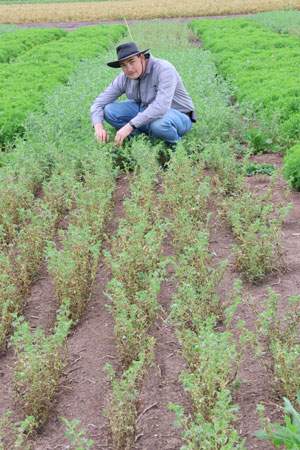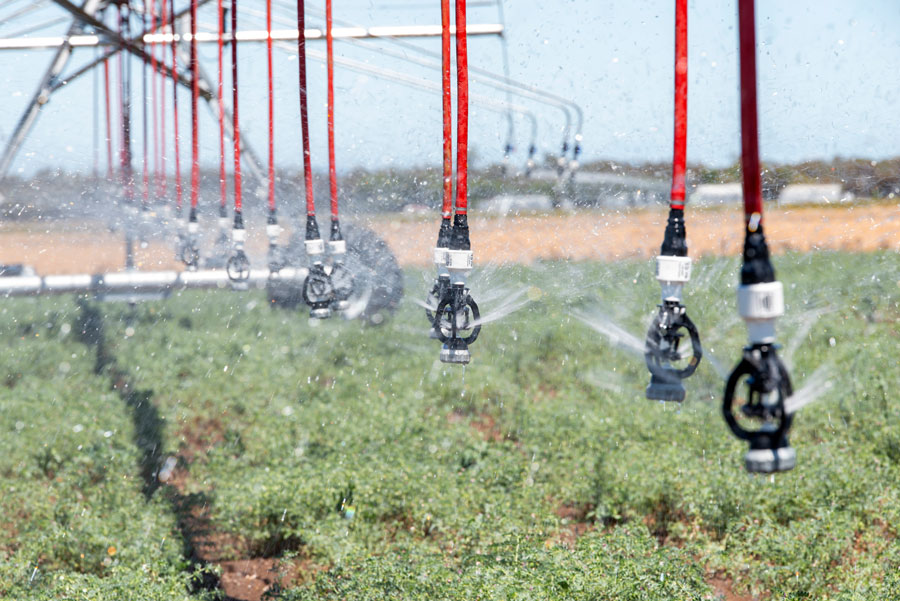Simulating conditions for Ascochyta blight disease screening has been challenging but has now been achieved with high throughput.
High-capacity, cost-effective, accurate and reliable Ascochyta blight screening is now a reality for chickpeas. It is the result of combining years of accumulated disease knowledge with perfecting screening techniques.
Dr Joshua Fanning from Agriculture Victoria leads the development of the GRDC-invested screening program and says Ascochyta blight is the highest-priority disease of chickpeas nationally. The program is part of GRDC’s five-pronged approach ‘Towards effective genetic and sustainable management of Ascochyta blight of chickpeas’.
“Ascochyta blight causes complete crop failure in the absence of suitable control. With limited genetic resistance available in commercial cultivars, growers are dependent on a restricted range of fungicides for disease control,” Dr Fanning says.
“This imperative is driving the development of chickpea varieties with improved resistance, together with identifying new sources of resistance. To do this, a high-capacity, cost-effective, accurate and reliable means of phenotyping or screening chickpeas for Ascochyta blight was essential for the Australian industry.
“This project was developed to provide high-throughput phenotyping in paddock and controlled environments for breeders, pre-breeders and researchers both within GRDC’s five-pronged Ascochyta blight initiative and more broadly.”
Method development
Dr Fanning explains that there is a considerable amount of knowledge on Ascochyta blight that underpins the design of the phenotyping service.
Over the years we have learnt about the epidemiology of the disease. We know that it has sexual and asexual reproductive capacity but only the asexual variant is present in Australia.
“Despite the reduced chance of genetic mutations of the disease due to the lack of sexual reproduction, there have still been several significant mutations resulting in the loss of varietal resistance in Australia.”
The disease spreads via fungal spores that are carried from crop residues into new crops by wind or through seed transmission. Infection can occur at any stage of plant growth, provided conditions are favourable.
 Dr Joshua Fanning assessing chickpea plants for Ascochyta blight in the phenotyping facility on Agriculture Victoria’s SmartFarm in Horsham. Photo: Agriculture Victoria
Dr Joshua Fanning assessing chickpea plants for Ascochyta blight in the phenotyping facility on Agriculture Victoria’s SmartFarm in Horsham. Photo: Agriculture Victoria
Moisture is essential for infection to occur and wet or foggy weather can exacerbate the disease as fungal spores are dispersed on to neighbouring plants by wind and rain splash.
Ascochyta can develop over a wide range of temperatures (5-30°C)
with leaf wetness key to disease development. Symptoms become visible in four to five days and fruiting bodies develop in fewer than 10 days. This allows rapid transmission.
“Horsham is an appropriate site for a large paddock-scale screening service as Victoria is home to Australia’s more-aggressive Ascochyta blight isolates, with both the major resistance breakdowns detected within Victoria,” Dr Fanning says.
“The site is also ideally located to challenge chickpeas with the most-relevant mix of stubble-derived isolates sourced from local growers.”
Fundamental to the paddock-based screening method, Dr Fanning says, has been the simulation of suitable environmental conditions conducive to the disease development in a reliable, repeatable way which can be used independently of seasonal conditions.
“Initially we started using infected stubble and a mister system to create rainfall drops and leaf wetness, which was automated. We started with a proof-of-concept approach over half a hectare, but we found it was cumbersome to sow plots in among a fixed set-up of pipes and misters.
“So, we moved to the use of a 57-metre automated lateral irrigator on the Agriculture Victoria SmartFarm and were then able to expand the area under irrigation to four hectares with a 25,000-plot capacity.”

Rain splash simulation by an automated overhead lateral irrigator for Ascochyta blight disease spread. Photo: Marty Shoo Photography
The site is irrigated at night or early morning to maximise the spread of disease and minimise the use of the water. The Horsham SmartFarm operators are currently installing a reverse osmosis plant to treat the town effluent, dams for storage and looking at solar panels on the dams to operate pumps and reduce water evaporation.
“We have worked with the statistics team from the University of Adelaide to further develop our methodology to determine the optimum number of replications and the spreader density of infected stubble to reduce variability as much as possible. This is generating highly accurate results.”
During 2022, 2867 genotypes (8517 rows in a partially replicated design) were phenotyped in this facility for resistance to Ascochyta blight. These genotypes were for other programs in the Ascochyta investment led by the South Australian Research and Development Institute (SARDI) and for Chickpea Breeding Australia.
Dr Bikram Banerjee, in the Agriculture Victoria team, is now exploring the potential for drone imaging to speed up the assessment of disease level on plants and to relate the images captured to the use of molecular markers.
To complement the field program, in 2022 a new state-of-the-art glasshouse facility opened at the Horsham SmartFarm.
“This facility is used across all research programs at Agriculture Victoria, but is also used to screen chickpea material against specific Ascochyta blight isolates in a very controlled way,” Dr Fanning says.
It is important to complement the field work with controlled environment screening so that isolates from other states can be safely screened in Victoria.
Understanding the pathogen and how it causes disease is an important step in understanding why we lose resistance in chickpea varieties.
This part of the Ascochyta investment is led by Griffith University, with national collaborators.
To ensure all organisations in the five programs of the Ascochyta investment are screening material similarly, a diverse set of chickpea lines were screened by SARDI, Curtin University’s Centre for Crop and Disease Management and Agriculture Victoria. This is known as ‘Ring testing’ and it ensures that, nationwide, consistent and accurate results are provided. It also regularly verifies that the test methods being used across Australia are reliable and reproducible.
During 2022, a total of 10,500 chickpea pots were sown in the glasshouse to assess the pathogen aggressiveness of 194 Ascochyta blight isolates and the Ring test.
Due for completion next year, this project will ensure that breeding and pre-breeding efforts to release varieties with improved resistance to Ascochyta blight will not be limited by the ability to determine the resistance accurately.
More information: Dr Joshua Fanning, [email protected]

























































